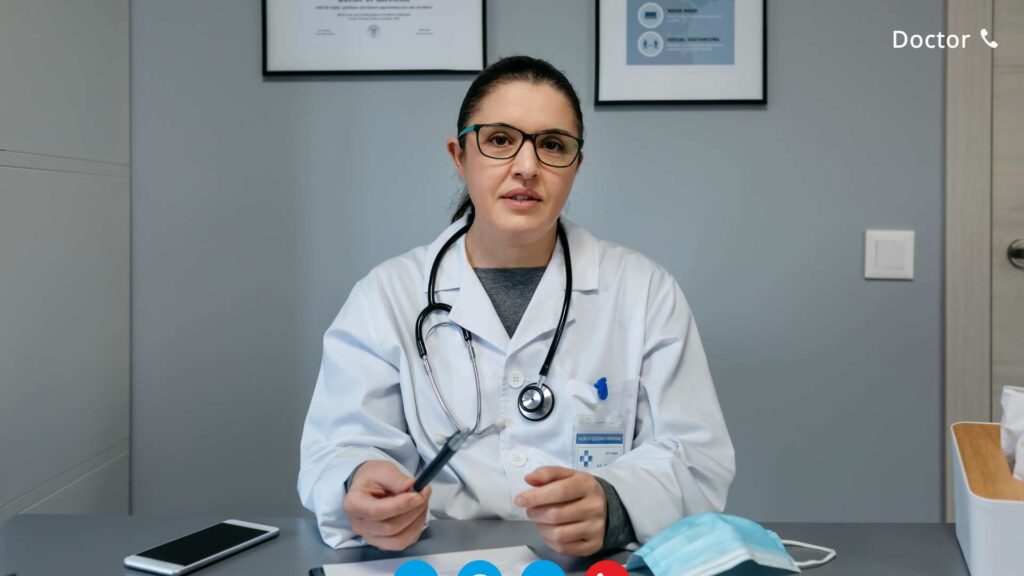Table of Contents
Thanks to its convenience, telehealth has improved access to healthcare for many people. You could consult an expert pediatrician from your home without having to reschedule, worry about traffic, or wait in a crowded room filled with unwell kids.
For some, simply going to a doctor is enough to cause jitters. A virtual consultation can remove such fears. This blog details everything you must know while preparing for a virtual pediatrician visit. Read on to learn more.
When to Use a Virtual Pediatrician Visit
Virtual pediatric visits are best suited for non-urgent medical concerns. If your child is experiencing life-threatening symptoms—such as difficulty breathing, severe allergic reactions, or high fevers in very young infants—you should seek emergency care immediately.
However, a virtual visit is appropriate and ideal for many common issues. Examples include:
- Mild cold or flu symptoms (runny nose, mild cough, sore throat).
- Low-grade fever (without severe lethargy or dehydration).
- Skin rashes or minor allergic reactions.
- Pink eye or mild eye irritation.
- Ear discomfort without severe pain or discharge.
- Digestive issues such as mild diarrhea or constipation.
- Follow up on chronic conditions like asthma or eczema.
- Prescription renewals for ongoing medications.
Virtual visits are also helpful for behavioral health concerns, such as discussing sleep issues, eating habits, or anxiety symptoms. They’re particularly valuable for families in rural areas, parents juggling multiple kids, or situations where transportation is challenging. In these cases, telehealth saves time with no stress.
Setting Up Your Technology
A smooth telehealth appointment begins with the proper setup. While the technology requirements are simple, preparing beforehand ensures you can focus on your child and the conversation, not troubleshooting your device.
- Choose the right device:
- A tablet or laptop often works best because it provides a larger screen and more stable positioning.
- A smartphone works fine, too—just make sure you can prop it up so you don’t have to hold it the entire time.
- Ensure a stable internet connection:
- Run a quick speed test; most telehealth platforms recommend at least 5 Mbps download and upload speeds.
- Sit closer to your Wi-Fi router or connect via Ethernet.
- Test your camera and microphone:
- Ensure the room’s lighting is bright but not directly behind you (avoid backlighting).
- Test audio beforehand—your pediatrician needs to hear your child’s breathing and speech.
- Protect privacy:
- Choose a quiet, private space where your child feels comfortable.
- Use headphones if discussing sensitive topics, especially for older children.
Pro tip: If your child needs to move around during the visit—like walking for a limp assessment—be sure your camera setup allows for movement without losing visibility.
Preparing Your Child—and Yourself
Children can feel nervous about seeing the doctor—even virtually. The difference is that they’re in their own homes, which can make the process smoother if you prepare them well.
For younger children:
- Explain what will happen: “We’re going to talk to the doctor on the computer so they can help you feel better.”
- Let them know the doctor might ask them to open their mouth, show their tummy, or move their arms.
- Keep a favorite toy or blanket nearby to help them feel secure.
For older kids and teens:
- Involve them in preparing for the visit—let them help write down symptoms or questions.
- Remind them that the doctor is there to help and that they can speak openly.
For parents:
- List your child’s symptoms, when they started, and anything that makes them better or worse.
- Note any recent exposures to illness, like a classmate with strep throat or Covid-19.
- Keep recent temperature readings or other measurements (like weight if relevant) handy.
Adding a calm, upbeat tone before and during the call can help your child see the visit as a normal, safe experience rather than something to fear.
Gathering Information for the Appointment
Your pediatrician will make the best recommendations if they have clear, accurate information. Before the visit, gather:
- List of medications your child currently takes, including vitamins or supplements.
- Recent temperature readings—note if you’ve used oral, ear, or forehead thermometers.
- Symptom timeline—write down when symptoms began and any changes since then.
- Allergies—include food, medication, and environmental allergies.
- Recent exposures—like being around someone sick or traveling recently.
Take clear photos beforehand if the visit involves a rash, swelling, or injury. If your camera quality isn’t perfect, the pediatrician can still see the details.
Effective Communication During the Visit
The quality of a virtual appointment depends on how well you share your child’s symptoms and concerns. Here’s how to get the most out of your time:
- Be clear and concise:
- Start with your primary concern: “My son has had a sore throat for three days and a mild fever.”
- Mention key facts: when it started, whether symptoms are worsening, and any home remedies you’ve tried.
- Show, don’t just tell:
- Use your camera to show visible symptoms—like a rash, swelling, or eye redness.
- If your child is coughing, let the pediatrician hear it.
- Ask questions:
- “What signs should I watch for that mean I need to take my child to urgent care?”
- “How can I manage symptoms at home?”
- “Are there foods, activities, or medicines I should avoid?”
- Involve your child:
- If they’re old enough, let them answer questions. This helps the pediatrician gauge their condition and comfort level.

Follow-Up Care and Prescriptions
At the end of the appointment, your pediatrician will review the following steps, ensuring you fully understand what comes next for your child’s care. This may include:
- E-prescriptions are sent to your pharmacy so you can pick up medications without dropping off a paper prescription.
- At-home care instructions include how to safely manage a fever, when to use over-the-counter medicines, what signs to watch for, and guidelines for when your child can return to school or daycare.
- Follow-up visits might be virtual for convenience or in-person if your child needs a physical examination, lab work, or more specialized attention.
E-prescriptions make life much easier for busy families. You can confirm your preferred pharmacy during the visit, and the prescription will often be ready within minutes or hours. Many telehealth platforms also offer automatic reminders when refills are due, helping parents stay on top of treatment plans and reducing the risk of missed doses. Some systems even allow you to request refills through the app without another appointment, which is especially useful for managing ongoing conditions like asthma, allergies, or eczema.
In addition, certain telemedicine services integrate with your child’s electronic health record (EHR), meaning any new prescription is visible to other healthcare providers in your child’s care team. This prevents duplication, avoids potential drug interactions, and supports coordinated treatment. For children with complex health needs, this streamlined process can make a significant difference in maintaining consistent, safe, and effective care.
Using Beem Health for Pediatric Telemedicine
If you want a platform designed with families in mind, Beem Health offers a streamlined experience for pediatric telehealth:
- Unlimited consultations with board-certified pediatricians.
- 24/7 chat support for quick questions between appointments.
- Same-day scheduling to address concerns without waiting days.
- Integrated health records so you can track your child’s care over time.
For busy parents, having this in one app means less stress and better continuity of care.
Handling Emergency Situations
Telemedicine is powerful, but it’s not a replacement for emergency care. Seek immediate medical attention if your child experiences:
- Trouble breathing or bluish lips/skin
- Seizures
- High fever in an infant under three months
- Signs of severe allergic reaction (swelling of tongue/lips, trouble swallowing)
- Persistent vomiting or dehydration
- Loss of consciousness
If you’re unsure, most telehealth services—including Beem Health—can help you decide whether to continue virtually or go straight to urgent care.
Connecting With Other Family Health Services
Virtual pediatric care is just one part of a complete telehealth plan. Many families also benefit from:
- Chronic care management—especially if your child has asthma, diabetes, or other long-term conditions.
- E-prescriptions—to simplify renewals for recurring medications.
- Virtual mental health visits for kids—especially for anxiety, ADHD, or stress related to school and life changes.
A connected digital health system allows your pediatrician, specialists, and therapists to share information so your child gets consistent care.
Conclusion
Preparing for a virtual pediatrician visit can help ensure the appointment goes smoothly and effectively. This blog offers a checklist and ultimate tips to guide you. However, one must remember that virtual pediatric visits are best suited for non-urgent medical concerns.
Beem Health offers accessible digital tools for those seeking help with virtual doctor consultations. For any financial aid, you can check out Beem, a smart wallet app trusted by over 5 million Americans with features from cash advances to help with budgeting and tax calculations. In addition, Beem’s Everdraft™ lets you withdraw up to $1,000 instantly and with no checks. Download the app here.
FAQs for Preparing for a Virtual Pediatrician Visit
Can my child get a diagnosis without an in-person exam?
Yes—many common pediatric conditions can be diagnosed virtually, especially if you share clear descriptions, images, and symptom timelines. However, your pediatrician may recommend an in-person exam for issues requiring lab tests or hands-on evaluation.
Does insurance cover virtual pediatric visits?
In many cases, yes. Most insurance providers now cover telehealth visits at the same rate as in-person care, but it’s always a good idea to confirm with your plan.
Can I have multiple children seen in one virtual appointment?
It depends on the provider. Some will allow back-to-back evaluations in the same call, while others may require separate appointments for accurate recordkeeping and billing.















































